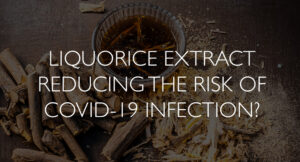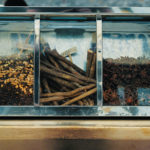 #Glycyrrhizin, the sweet tasting constituent of #liquorice root, has previously been highlighted for its role as a natural #anti-viral. As a result of the current #COVID-19 global pandemic the spotlight has again been shone upon the natural compound in the hope it could reduce the risk of infection. The previously unknow #pathogen, designated as severe acute respiratory syndrome #coronavirus 2 (#SARS-CoV-2), spread worldwide within a few weeks. SARS-CoV-2 is considered to share 79.5% of the genetic sequence of #SARS-CoV and to have the same cell entry receptor, angiotensin-converting enzyme II (#ACE2). As a result, scientists can take previous SARS-CoV clinical knowledge and research into account in their attempts to manage Covid-19 related infection risk. Glycyrrhizin was found to be one of the most promising candidates in fighting against SARS-CoV, and research has now been published by Huazhong University of Science and Technology, China.
#Glycyrrhizin, the sweet tasting constituent of #liquorice root, has previously been highlighted for its role as a natural #anti-viral. As a result of the current #COVID-19 global pandemic the spotlight has again been shone upon the natural compound in the hope it could reduce the risk of infection. The previously unknow #pathogen, designated as severe acute respiratory syndrome #coronavirus 2 (#SARS-CoV-2), spread worldwide within a few weeks. SARS-CoV-2 is considered to share 79.5% of the genetic sequence of #SARS-CoV and to have the same cell entry receptor, angiotensin-converting enzyme II (#ACE2). As a result, scientists can take previous SARS-CoV clinical knowledge and research into account in their attempts to manage Covid-19 related infection risk. Glycyrrhizin was found to be one of the most promising candidates in fighting against SARS-CoV, and research has now been published by Huazhong University of Science and Technology, China.
Research has shown a strong interaction between SARS-CoV-2 and human ACE2, the protein on the surface of many cell types. With glycyrrhizin having been shown to have the potential to bind to ACE2 it may well be able to be considered as a potential treatment for Covid-19 utilising the anti-viral effect it was shown to have on SARS-CoV-2 in silico testing. A large population of critically ill patients with severe Covid-19 have been observed to be suffering with #cytokine storm, a process mediated by the overproduction of proinflammatory cytokines, including interferons (IFNs), tumour necrosis factors (TNFs), interleukins (ILs), and chemokines. Cytokine storm can lead to acute #respiratory distress disease, #septic shock and ultimately multiple organ failure. Glycyrrhizin has cytokine-modulating activity and may be able to modify the immune response, with fewer side effects than #glucocorticoids previously used during the SARS outbreak of 2003. The compound is also able to inhibit the accumulation of intracellular reactive oxygen species (#ROS) caused by virus infection.
With no current, specific, medical interventions available for Covid-19 it is vital that we identify novel, and effective treatments to benefit patients. The article from China clearly shows the various pharmacological effects of glycyrrhizin, and it offers potential to be a promising agent in overcoming the disease. The compound has been safely used throughout the world for millennia and is considered to have low toxic potential, however excessive consumption can result in #potassium wasting, so caution must be given. With potassium wasting having been a noted side effect of both SARS Cov-2 itself, as well as the drug hydroxychloroquine, currently being investigated as a treatment for COVID-19, serum potassium would need to be monitored throughout glycyrrhizin treatment to prevent any related cardiovascular or kidney adverse effects. However, if considering its use utilise the Dosage recommended by the German Commission E monograph, where the average daily dosage prescribed is 5 g to 15 g of root, equivalent to 200 to 600 mg of glycyrrhizin or equivalent preparations.
Read More
https://www.ncbi.nlm.nih.gov/pmc/articles/PMC7180159/
https://www.ncbi.nlm.nih.gov/pmc/articles/PMC4629407/






1 Comment. Leave new
The activity of components of Licorice root have been confirmed in vitro against SARS-CoV-2:
https://doi.org/10.1101/2020.05.02.074021
https://doi.org/10.1101/2020.12.18.423104